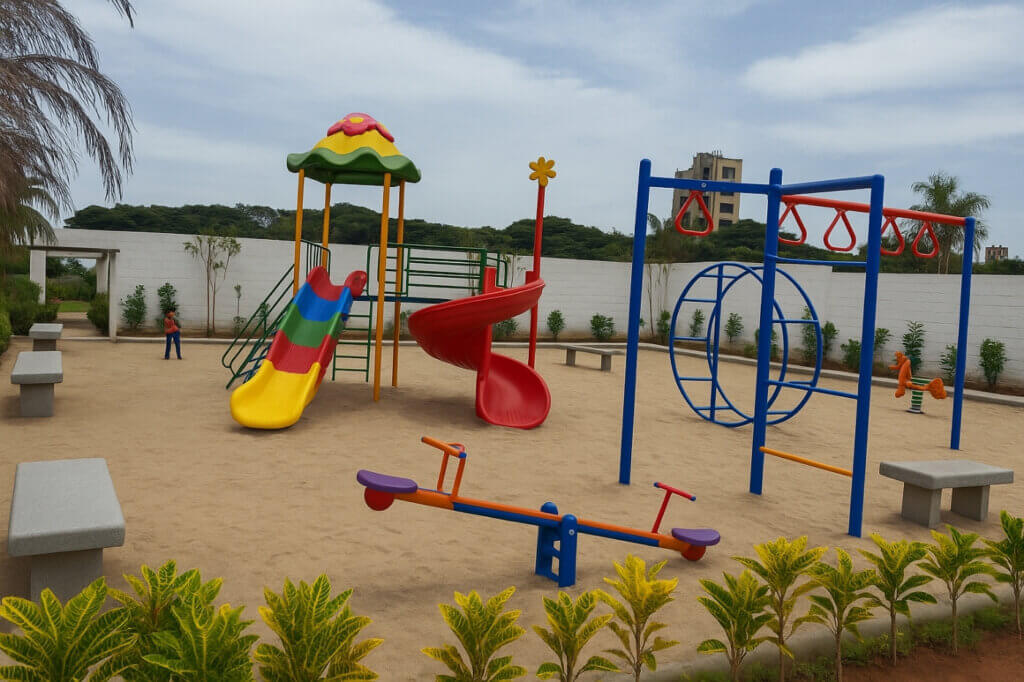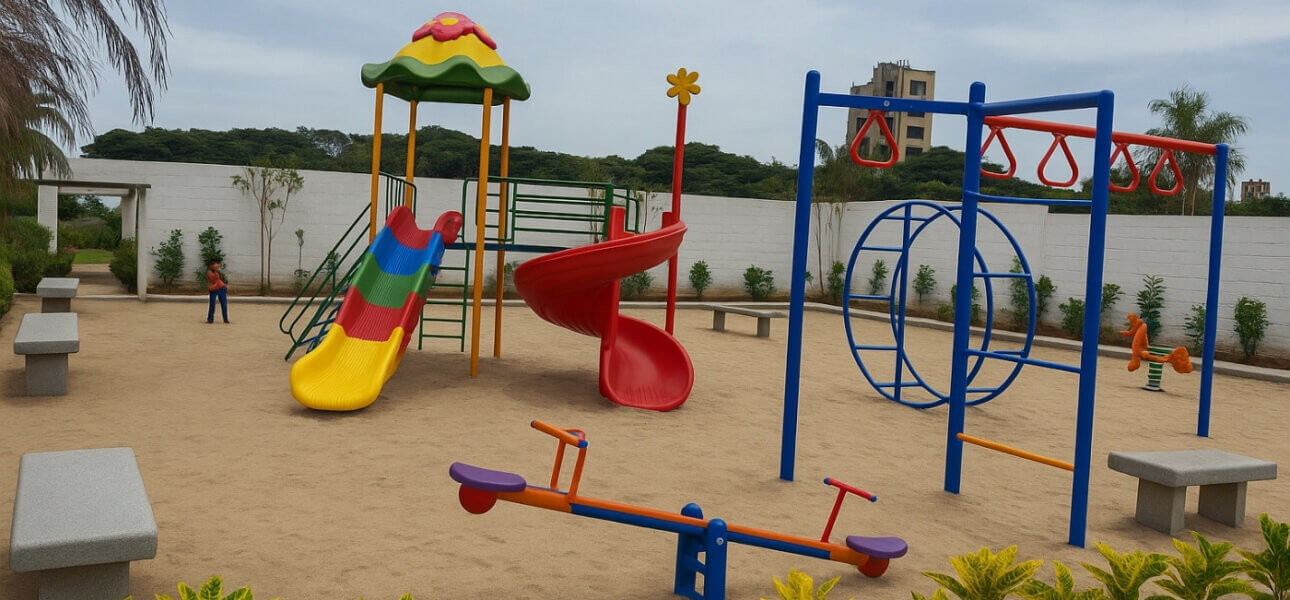Monsoon is beautiful until water sits at your doorstep. A rain-ready home keeps you dry, protects your walls and foundation, and saves you frequent maintenance headaches. If you are planning a villa on a Padappai plot or upgrading your existing house, a little foresight on canopies, drains and path slopes will make your home truly all-weather.

Why rain planning matters in Chennai’s climate
Chennai and the Padappai Oragadam belt receive short but intense spells. In these bursts, water finds the quickest path. If that path leads to your portico or foundation, you face damp walls, slippery floors and damaged plaster. Good design turns rain into a guest that arrives, flows through, and leaves quietly. Think of it as three layers of defence. Keep water off with canopies. Guide water away with drains. Move water out with proper path slopes.
Canopies that actually work
A canopy is more than a pretty eyebrow over your door. It is your first shield against splash and wind-driven rain.
- Over-door canopies: Extend at least 600 to 900 mm beyond the door frame so wind-blown rain does not creep in. Add a drip edge so water falls clear of the threshold.
- Window hoods: Small projections or louvered awnings reduce direct rain entry and protect wooden frames and mesh.
- Portico roofs: If you are planning a car park, a light but sturdy portico with polycarbonate or tiled roofing reduces splashback on the main wall.
- Balcony and sit-out covers: Transparent sheets above sit-outs keep daylight while cutting rain. Use UV-stabilised sheets and proper guttering so water does not pour on the lower floor.
- Material picks: Powder-coated steel, aluminium, fibre cement sheets, clay tiles or toughened glass on steel frames. Avoid untreated mild steel near sea breeze zones.
Tip: Always tilt canopies slightly to the side where a gutter or downpipe is waiting. Never let water drip onto steps or the main walkway.
Path slopes that keep your feet dry
Slopes are the silent hero of a rain-ready home. Even a beautiful paving will fail if it is level or tilting towards the house.
- Set the reference: Your finished floor level should sit clearly above the surrounding ground. A neat plinth step keeps splashes off walls.
- Driveway gradient: Keep a gentle fall away from the house towards the gate or side drain. A practical target is around one centimetre per metre fall for paved areas.
- Walkway falls: From walls to garden, allow a slight outward slope so water cannot stand near the foundation.
- Threshold ramps: Where you need accessibility, use a mild ramp with lateral grooves. Pair it with a trench drain on the outer edge so the ramp never becomes a water slide.
- Textured surfaces: Choose anti-skid pavers or stamped concrete with fine grooves. This helps during sudden downpours common in Padappai.
Pro move: After paving, do a bucket test. Pour a bucket of water and see the flow. Correct with additional screed or re-laying before the monsoon.
Drains that look neat and drain fast
Drains should be easy to clean, hidden where needed and strong under wheels.
- Perimeter trench drains: Slim channel drains along the wall base collect splashes and rooftop runoff. Cover with stainless or polymer grating for a clean look.
- Catch pits at corners: Place small pits at natural low points. Fit silt baskets so leaves and mud can be lifted out in seconds.
- Downpipe connections: Every roof should have enough downpipes. Connect them to recharge pits or a stormwater line and never to the septic system.
- Recharge and rainwater harvesting: In the Padappai belt, groundwater recharge is a smart habit. Direct clean roof water to a filter and a recharge well. Garden water can pass through a silt trap before it enters the ground.
- Garage and wash area drains: Use floor traps with removable strainers. Slightly recess the floor and give a clear fall to the trap.
Good practice: Map your entire rainwater path on paper. Roof to downpipe. Downpipe to filter. Filter to storage. Overflow to recharge or municipal drain. No dead ends.
Detailing to avoid splash and seepage
Small details make a big difference in a coastal city.
- Drip courses: Provide a drip groove under all projections so water falls away from the wall.
- Damp proof course: Ensure a proper DPC above plinth level. Without this, capillary moisture will stain your walls after each season.
- Protective skirting: A tiled or stone skirting along external walls resists mud splash and is easier to wash.
- Sealants and joints: Use exterior-grade sealants at canopy junctions and window perimeters. Inspect yearly before the rains.
- Gutter guards: Simple mesh guards reduce leaf clogging, especially if you have neem or rain trees nearby.
Materials for the monsoon performer
- Pavers: Interlocking concrete blocks or cobbled pavers with sand joints are flexible and easy to re-level.
- Concrete: Stamped or broom-finished concrete gives grip and looks premium in a villa layout.
- Natural stone: Flamed granite or leather-finish stone offers superb traction and long life.
- Roof sheets: High-quality coated sheets with proper flashings prevent leaks at junctions.
Maintenance checklist before and after the rains
- Clear leaves from gutters and downpipes.
- Remove silt from catch pits and trench drains.
- Check canopy fasteners and sealant lines.
- Power wash paving and re-sand paver joints if they washed out.
- Inspect for damp patches and touch up exterior paint where needed.
How this plays out at Velammal Garden
Villa plots at Velammal Garden benefit from wide internal roads, green pockets and faster runoff to the layout’s stormwater network. When you plan your home, align your driveway fall towards the plot frontage and connect rooftop downpipes to your rainwater harvesting. This approach keeps your plot dry, protects your structure and adds to long term value. To explore plot options, layouts and rain-ready design tips, visit velammalgarden.com and book a site walk. You can also check the latest availability and offers on velammalgarden.com.
Simple sample layout for a 30 by 50 plot
- Portico canopy projecting well beyond the car footprint with a drip edge
- Trench drain along the portico outer line leading to a catch pit near the gate
- Walkway sloping away from the main wall with textured pavers
- Two downpipes per roof slope connected to a filter and recharge well
- Backyard kitchen wash area with a floor trap and grease screen
Business case for rain-readiness
A well-drained, low-maintenance home is a selling point. Buyers in Chennai prefer homes without damp marks, algae streaks or pooled water in the driveway. Upfront spending on canopies, drains and correct slopes returns value through lower repaint cycles, fewer repairs and better resale impressions.
Call to action
If you are planning your dream home in Padappai, get the rain strategy right upfront. When you visit Velammal Garden, ask for the rain-readiness checklist and a quick plot slope review. This small step will make your home comfortable through every monsoon that Chennai sends your way.
FAQs: rain-ready homes canopies drains & path slopes villa plots lifestyle Padappai
What is the ideal slope for a driveway or path at home
Aim for a gentle fall away from the house so water runs to a drain or the gate. A simple rule is about one centimetre per metre of length for paved areas. Always test with a bucket of water before finalising.
Do I really need canopies if my doors are recessed
Yes. Recessed doors reduce direct rain but wind-driven showers are common in Chennai. A canopy with a drip edge keeps thresholds dry, protects woodwork and reduces mop-ups.
How can I keep drains from clogging during peak rains
Fit trench drains with removable gratings and catch pits with silt baskets. Add simple leaf guards to gutters. Schedule a quick cleaning before and after the monsoon to keep flow smooth.
Is rainwater harvesting practical on a small villa plot in Padappai
Absolutely. Connect roof downpipes to a compact filter and a recharge well. Even a short spell can fill storage or recharge the ground. It saves water bills and supports the local water table.
What paving is safest during rains for elderly family members
Choose textured finishes like flamed granite, anti-skid concrete or good quality pavers. Pair this with correct slopes and a trench drain near steps so surfaces stay grippy and dry.
Ready to plan a rain-ready villa in a green, well-connected community Close the loop with a site visit at velammalgarden.com and see how your home can welcome the monsoon with confidence.


